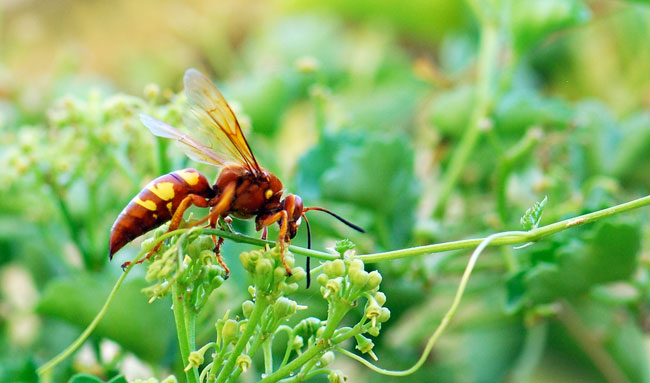
Bumblebees
You are four. The tops of meadow grasses and wildflowers brush your shoulders as you wander. Mid-stride, you yelp and look down. A spiky black and yellow ball has attached itself to your knee, a malevolent growth. You shriek and shriek and shriek. Your mother arrives, brushes it away, and in an irritated tone says that it is just a bumblebee.
The sharpness of her voice is the more lasting pain.
Honeybees
It is summer. You run through the short-cropped lawn and stomp on a pale clover flower with a bare foot. The honeybee gathering food on it protests your intrusion by thrusting her stinger into your skin. You hop on one foot to your grandmother. She mixes baking soda with a little water and spreads it on the injury. She pats your hand and assures you that the gray paste will take the venom away. Hours later you have forgotten all about it.
Carpenter Bees (The Non-Sting Sting)
In front of your house, head-tall barberry shrubs crowd close to the path. Each spring the bushes erupt with insignificant pale flowers and with the flowers come handfuls of amber and ebony bees that you think are bumblebees. You must pass through this gauntlet every day to get on the school bus. You wait until the last minute to open the door and sprint by at full speed, to arrive at the bus winded but unscathed. Until you reach school.
Years later you learn the barberry bees are carpenter bees. They sting so rarely that there are myths they lack stingers. The carpenter bees’ main defense is to resemble something that is likely to use its weapon. Being scared of them is a waste of fear.
The Young Man Who Studies Bees
You go to graduate school to study a type of ant that does not sting. You run into a low-key young man who studies bees. You know him. After a party two years before, you and he had leaned up against the door of your car on a warm Colorado night and exchanged life stories — not like business cards, but like bites of a sumptuous meal. A few weeks later you leave the state, taking a more difficult, convoluted path. He stays on the straight, successful path.
Now you are both at Cornell. Life is serious. You and the young man have classes together, study together, and go to the same parties. You set your sights on another young man, the one your married best friend has deemed a great catch. Shortly after you and the catch start dating, you see the pain in bee man’s eyes. The attraction was so quiet that you had missed it, and you realize with a lancing pain of regret that now it is too late.
A few years later, you learn he has passed away. An assistant professor at a university in the Midwest, the reports say he died alone at night while grading papers. You envision his blond head hunched over a wooden desk with the glow of a lamp his only companion.
Scorpions
You follow the catch to Arizona. You get married, buy a house, and have a son.
You hear about scorpions, even see a few. One night you pick up a band-aid box left on the counter of your son’s bathroom and a scorpion nails you on the finger. You pack ice around the injured appendage and pull out the number of Poison Control in case you have any problems, because the Arizona bark scorpion sting can be lethal. Your husband digs out the antihistamine and wrings his hands while you take it.
The pain is creepy, like nano-alligators have latched onto your nerves and are thrashing around. Finally you sleep. The next day, and the next, your finger is numb, a region of unfeeling negative space in everything you touch.
Bumblebees (Again)
When your son is about four, you play together in the garden. Suddenly, a bumblebee lands on his forehead and stings him. You gather him up and take him inside the house. You ask him how he is. A cold pack of peas, a few tears, and soon he is fine. You call the exterminator to remove the bumblebee nest that had been growing in a compost bin only three feet from the garden. You watch from behind glass as thumb-sized bees, determined to protect their offspring, hit and bounce off the exterminator’s white protective suit.
You wonder what your son will remember.
 Roberta Gibson has no idea what she wants to be when she grows up. Trained as a scientist, she’s trying out a second career as a writer. When she’s not scribbling, she can be found at martial arts class, reading, taking photographs, or gardening. See how it’s all going at Roberta Gibson Writes.
Roberta Gibson has no idea what she wants to be when she grows up. Trained as a scientist, she’s trying out a second career as a writer. When she’s not scribbling, she can be found at martial arts class, reading, taking photographs, or gardening. See how it’s all going at Roberta Gibson Writes.


